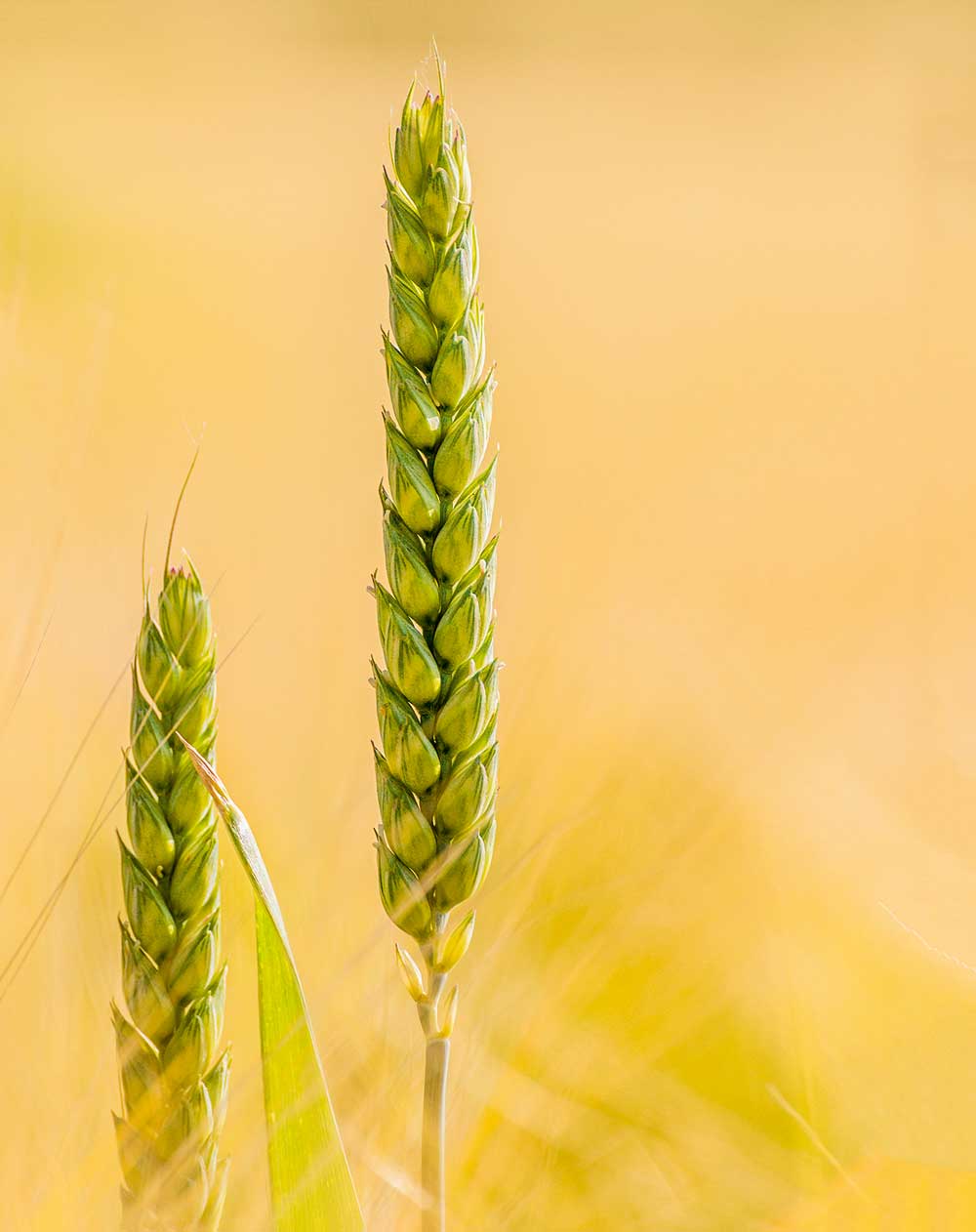Climate change: Are there cereal varieties for heat and drought?
Interview by Dr Christian Bickert, DLG Mitteilungen
Climate change has many aspects! There is increasing drought, radiation and heat stress, but also the increase in heat-loving pests. How can you counter these risks? Sven Böse, Saaten Union, explains what cereal growers can do.
Mr Böse, are cereal farmers helpless in the face of climate change?
No, certainly not! Our cereal varieties are downright adaptation artists when it comes to their reaction to different vegetation patterns. Thus, favourable growing conditions can be used for peak yields, whereas losses remain within limits in stress situations.
Can you give an example?
Absolutely. In years with extreme spring drought, for example, stand density - seen across all varieties - loses importance for yield. The individual ear weight, and in particular the number of grains per ear, becomes all the more important. Late secondary shoots are reduced in favour of stronger ears of the main stem.
The increasing dynamics of growth processes play an important role in yield formation and variety selection. Nationwide surveys by the German Meteorological Service (DWD) show clear trends in this respect: since 1990, winter wheat shoots 13 days earlier, ear emergence almost 12 days earlier and yellow ripening a good 16 days earlier!
Does it mean, we will harvest wheat in July soon?
In the long term, that is conceivable. Because the individual growth phases have hardly shortened: even if tillering ends almost two weeks earlier today, it is hardly shorter than it was 30 years ago, because dormancy starts later in autumn. The phases from shooting to ear emergence and then to yellow ripening are also only about 2 days shorter today than 30 years ago. This is compensated by higher growth rates due to the higher light and temperature availability.
If this development continues, winter wheat would not be harvested at the end of July in another 30 years, but already in mid-July!
But aren't we then giving away growing time at the expense of yield?
Not necessarily. In order to make efficient use of the growing season, a new type of wheat variety could be introduced in the next few decades: Sufficiently winter-hardy alternate varieties with less need for vernalisation, which shoot and flower earlier thanks to lower daylength requirements. The genetic background for this is known: The ripening time is controlled by the genome in a very complex way, the reaction to cold stimuli, on the other hand, is mainly controlled by two genes. We can reduce the light reaction with a single gene mutant. Their insertion is already happening today in conventional breeding.
Frost can definitely still happen. Are our wheat varieties ready for this?
Breeding progress is "dealing with the past". The development of new varieties is largely done in the open. The strains that were best able to cope with the biotic and abiotic stresses of previous years are selected, registered and approved. Thus, each variety vintage is the result of the associated testing history - and thus also of climate change. This applies, for example, to diseases, frost or storage - and in recent years especially to drought, heat and radiation stress.
The enormous influence of year effects on variety diversity is impressively demonstrated by comparing the 2020 and 2017 approval vintages, which reflect the 2014 to 2019 test years, i.e. those with both outstanding and most difficult yield conditions.
The wheat varieties approved in spring 2020 had to go through the "bottleneck" of the extremely dry and hot test years 2018 and 2019, which were characterised by spring drought with very rapid development and often low stand densities. It is therefore no coincidence that not one (!) of the 18 new registrations can be characterised as long-day or grain density type. On the contrary, all registrations are earlier or medium in ear emergence and, in terms of yield type, mostly TKM-strong or single-ear-strong.
Conversely, the 2017 registrations followed the high-yield years 2014 to 2016. All three test years were characterised by high grain numbers per m² after good youth development. Only a few single-ear types made the running under these conditions, rather mainly grain density types, including numerous later ones. Even more remarkable: Not a single (!) of the 17 new registrations of this vintage was able to develop into a large variety in the dry years after registration.
Are early-flowering varieties a solution?
While early-flowering varieties will generally become more important as the climate warms up, the ripening period needs to be addressed in a more differentiated way: Early maturity is not only in demand in regions with regular early and rapid ripening, but also in early summer drought. However, for high yields, early-maturing varieties need good youth development with sufficient water supply. This is often not the case during autumn or spring drought. The stand densities are then too thin. This is especially true for the grain density types that dominate in the early maturity range. They can compensate for thinner stands only slightly through grain weight. Later maturing varieties, on the other hand, can still make efficient use of precipitation from May onwards. Therefore, it was mainly large-grain varieties or single-row types that were convincing in many places in the dry year 2019, for example.
Is it just matter of chance what individual varieties are really capable of?
In some areas this is indeed the case. The more intensively one analyses the results of variety trials, the more such interactions between variety and environment are found. This applies to differences in yield structure as well as to differences in development, straw properties or resistance. Each new generation of varieties shows a different safety profile. For example, almost only very yellow rust-resistant varieties were approved in 2017 and 2018. These had to go through the bottleneck of the 2014 yellow rust epidemic, either in the first evaluation year or in the breeder pre-test. Winter resistance, on the other hand, has hardly been demanded of new varieties for years. Consequently, there is no significant differentiation in the trials and thus no classification!
Are you telling us that variety selection is just a simple lottery game?
Not at all! When choosing varieties, it is important to distribute the annual risk among varieties with different genetic backgrounds. This applies to resistance as well as to differences in development and yield structure. In wheat we essentially distinguish between three yield types:
- Grain density types. Later varieties from this group embody the Atlantic variety type. They are most likely to show their strengths on high-yielding sites with slow maturity. Earlier varieties in this segment suffer less from the July heat and are also suitable for early threshing sites. For good grain development, however, they belong on medium to better sites. Good stand establishment before winter is important. Therefore, they should not be sown too late or too densely, especially as the side shoots of these varieties hardly drop in yield.
- Single ear types. These varieties are well suited to higher altitude or continental locations with long dormancy and also to drier climates. Due to their apical dominance, they establish a lower number of weak secondary shoots in favour of a higher proportion of strongly rooted main stems. Single-stem varieties are particularly suitable for normal and later sowing dates. Because they do not require high stand densities, they are good insurance against drought stress in spring, but they tend to drop off under favourable growing conditions.
- Stand types. These combine the advantages of the first two groups of varieties: On the one hand, they fix a high proportion of the yield early via higher stand densities. Due to their strict negative relationship to the number of grains per spike, the latter is lower, which in turn favours the usually very good grain formation of this variety type. Not only currently, but also historically, many large and stable varieties can be assigned to this stand type. This type is obviously particularly adaptable and compensatory and can be used universally, but best after good preceding crops.
Let's draw a line under the developments: Is climate change harming us or are we actually benefiting from it in cereal cultivation?
A moderately warmer and drier climate than today is not necessarily detrimental to the yield formation of wheat and even more so of the less demanding winter cereals. However, with the shift from a "temperate" to a "dry-Mediterranean" climate, the risks of heat and drought stress increase considerably. The increasing spring drought of recent years has limited stand density in particular. This makes more stable individual ear yields all the more important in the future. This applies to all our common cereals.





